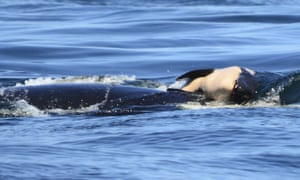
Researchers say an endangered killer whale that carried her dead calf on her head for more than two weeks has finally abandoned the calf’s body and is back to feeding and frolicking with her pod.
The Center for Whale Research in Washington state says it watched the orca, known as J35, chase a school of salmon in Haro Strait west of San Juan Island, between the US mainland and Vancouver Island, on Saturday afternoon.J35’s calf died soon after birth on 24 July. The mother carried the baby on her head for at least 17 days, in an image of grief that struck an emotional chord worldwide. he finally abandoned the carcass as it decomposed. Center for Whale Research founder Ken Balcomb said he was immensely relieved to see J35 returning to typical behaviour. Three years have passed since an orca residing in the area has birthed a surviving calf. In the past 20 years, 40 orcas have been born into the group while 72 have died. Only 75 killer whales in the endangered group, known as southern resident orcas, remain.
The Center for Whale Research in Washington state says it watched the orca, known as J35, chase a school of salmon in Haro Strait west of San Juan Island, between the US mainland and Vancouver Island, on Saturday afternoon.J35’s calf died soon after birth on 24 July. The mother carried the baby on her head for at least 17 days, in an image of grief that struck an emotional chord worldwide. he finally abandoned the carcass as it decomposed. Center for Whale Research founder Ken Balcomb said he was immensely relieved to see J35 returning to typical behaviour. Three years have passed since an orca residing in the area has birthed a surviving calf. In the past 20 years, 40 orcas have been born into the group while 72 have died. Only 75 killer whales in the endangered group, known as southern resident orcas, remain.

Killer whales are long-lived one Seattle-area orca known as Granny is believed to have lived 106 years before her death in 2016 but the remaining southern resident orcas must start reproducing again before they grow too old to calve. If they don’t, the ageing pods will dwindle for decades before the last orca dies. The whales are being deafened by sonar and boat noise in the sea, as well as a lack of Chinook salmon, their main source of food. However, with each salmon they catch, they are poisoned a little more as pollution accumulates at the top of the food pyramid. Dams, pollution and fishing have depressed Pacific north-west stocks of Chinook, which often appear in supermarkets as king salmon. For decades, environmentalists, tribal members and the fishing industry have called for the removal of dams on the Snake river often blamed for the fishery’s decline. Truly wild Chinook is a rarity; hatcheries prop up the commercial and recreational fisheries. Balcomb said in order to save the orcas, the population of wild salmon, not hatchery-raised fish, needed to be increased.“The larger environmental question reflected in the J35 story is that both the USA and Canada must redouble efforts to restore wild salmon … for a food supply for the [southern resident killer whales] in this region,” Balcomb said Friday. “Hatchery fish are inferior and non-sustainable, and farm fish, of course, are not available for whale consumption.”